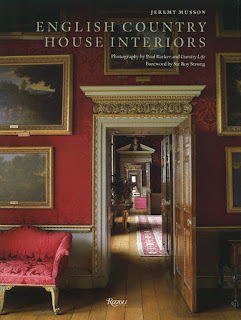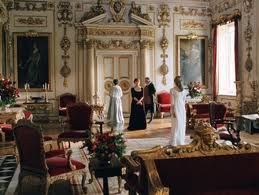Victoria, here. I recently met Jeremy Musson, author of a beautiful new book from Rizzoli: English Country House Interiors. As part of the programming at the Milwaukee Art Museum for the exhibition Rembrandt, Gainsborough and Van Dyke: Treasures from Kenwood, Mr. Musson presented stunning photographs and his accounts of writing this lovely volume.
I should come as no surprise to readers of this blog, that I am an eager student of all-things-stately-homes-and-British. So you can imagine the delight with which I met Mr. Musson, listened and watched his presentation, and devoured his book.
Jeremy Musson, at the Milwaukee Art Museum
Mr. Musson chose fourteen houses to chronicle in his study of the evolving interior styles from the 16th to the 21st centuries. I was pleased to find I had visited exactly half of his subjects, and just as happy to learn of seven more I can put on my to-do list for upcoming trips across the pond.
King James Library, Hatfield House, Hertfordshire
As a preface to my comments on this splendid volume, I have to apologize to Mr. Musson, to the primary photographer Paul Barker, and to the Country Life Archive collection. I did not have access to their photographs, which are far, far better than those shown in this blog, most of which originate from my camera or ordinary website views. The photos in English Country House Interiors are far, far better in every way — more detailed, more creative, more comprehensive and a feast for the eye. Please find an opportunity to see for yourself. Most houses in this volume remain as family homes, maintained by families for themselves as well as for the public. They were chosen specifically because these houses continue to evolve and change, not just as museums but as residences.
Hatfield House South Front
Hatfield House, first of Musson’s examples, was built in the early seventeenth century by Robert Cecil, Lord High Treasurer to King James I. Once owned by the crown, the estate was also the site of a palace which was a residence of the young Princess Elizabeth before she became Queen. Cecil’s house was sumptuous evidence of his importance; he hired the best of continental craftsman to create his decor. The Library above with the life-size statue of King James over the fireplace, was rehung with tapestries and paintings in recent years.
The house is a magnificent example of what we now call Jacobean architecture, bringing to domestic architecture all the extravagance of the High Renaissance. Next on Musson’s agenda is “The Courtly Caroline Interior” of Wilton House. The ivory and gilt interior is widely renowned for the Single and Double Cube rooms, which contain furniture made in a later period, by William Kent.
Wilton House, as used in the 2005 film version of Pride and Prejudice
I will not try to summarize the changing fashions of interior decoration as Mr. Musson explores Boughton House, Chatsworth , Castle Howard, Houghton Hall, and Holkham Hall.
His discussions of Harewood House and Syon House center on the “Genius of Robert Adam,” whose styles have influenced all interior design ever since.
Harewood House, Yorkshire
The gallery, below, was completed in the 1770’s for the Lascelles Family, whose fortune was rooted in Caribbean sugar business; they later became the Earls of Harewood and married into the royal family. The house was constructed for the family in the Palladian style and most of the decor was completed by Adam with much of the furniture supplied by Chippendale.
Harewood Gallery
Syon House, on the other hand, was a monastery before the Dissolution; as a possession of the Percy family, it was totally re-modeled and redecorated by Adam in the 1770’s.
Syon House, Long Gallery (Library)
Syon is the London area residence of the Duke of Northumberland, who took a few of his personal guests through the library one day in my presence, whilst completely ignoring the gaggle of tourists gazing at his fine rooms. He never once glanced our way. We were all duly impressed. And giggling.
After discussing the “Regency Revolution in Taste” at Goodwood House, Mr. Musson revisits a few houses to see various innovations made in the 19th century, then visits Arundel Castle, Waddesdon Manor, Berkeley Castle and Parham House. At each stop, he informs the reader about changing tastes and styles of interiors, whatever the exterior of the house might say.
Waddesdon Manor, Buckinghamshire
built in 1874 in the French Chateau style
In the spirit of Mr. Musson’s final chapter “Living Interiors: The English Country House Interior Today,” the picture below (not from the book), shows a drawing room redone at Waddesdon recently by leading English designer David Mlinaric.
You will love every word and every photograph in this book, and I must encourage you to take a look. Jeremy Musson’s
website is here.








What a gorgeous book! Sigh. Another one to add to the wish list. I would have been right there giggling with you!